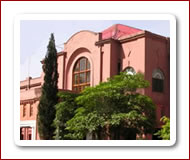| Enterotoxemia |
Etiology The causative agent is C perfringens type D. However, predisposing factors also are essential; the most common of these is the ingestion of excessive amounts of feed or milk in the very young and of grain in feedlot lambs. Transmission In young lambs, the disease usually is restricted to the single lambs, because a ewe with twins seldom gives enough milk to allow enterotoxemia to develop. In the feedlot, the disease usually is seen in lambs switched rapidly to high-grain diets. As the starch intake increases, it provides a suitable medium for growth of the causative bacteria, which produce toxin. A major effect of the toxin is to cause vascular damage, particularly of capillaries in the brain. Many sheep carry strains of C perfringens type D as part of the normal microflora of the intestine and serve as the source of organisms to infect the newborn. Most such carriers have nonvaccinal antitoxin titers. Clinical Findings Usually, sudden deaths in the best-conditioned lambs are the first indication of enterotoxemia. In some cases, excitement, incoordination, and convulsions occur before death. Opisthotonos, circling, and pushing the head against fixed objects are common signs of CNS involvement; frequently, hyperglycemia or glycosuria is seen. Diarrhea may or may not develop. Occasionally, adult sheep are affected; they show weakness, incoordination, and convulsions and die within 24 hr. In goats, the course of disease ranges from peracute to chronic, with signs that vary from sudden death to watery diarrhea with or without blood. Acutely affected calves not found dead show mania, convulsions, blindness, and death in a few hours. Subacutely affected calves are stuporous for a few days and may recover. In goats, diarrhea and nervous signs are seen, and death occurs in several weeks. Type D enterotoxemia occasionally is seen in young horses that have overeaten. Control If the disease is seen consistently in young lambs on a property, ewe immunization probably is the most satisfactory method of control. Breeding ewes should be given 2 injections of type D toxoid their first year, and 1 injection 4-6 wk before lambing and each year thereafter. Enterotoxemia in feedlot lambs can be controlled by reducing the amount of concentrate in the diet. However, this may not be economical, in which case, immunization of all lambs with toxoid when they first enter the feedlot probably will reduce losses to an acceptable level. Two injections, 2 wk apart, will protect lambs through the feeding period. When alum-precipitated toxoids or bacterins are used, the injection should be given at such a site that the cold abscesses, which commonly develop at the site of injection, can be removed easily during normal dressing and not blemish the carcass. |


